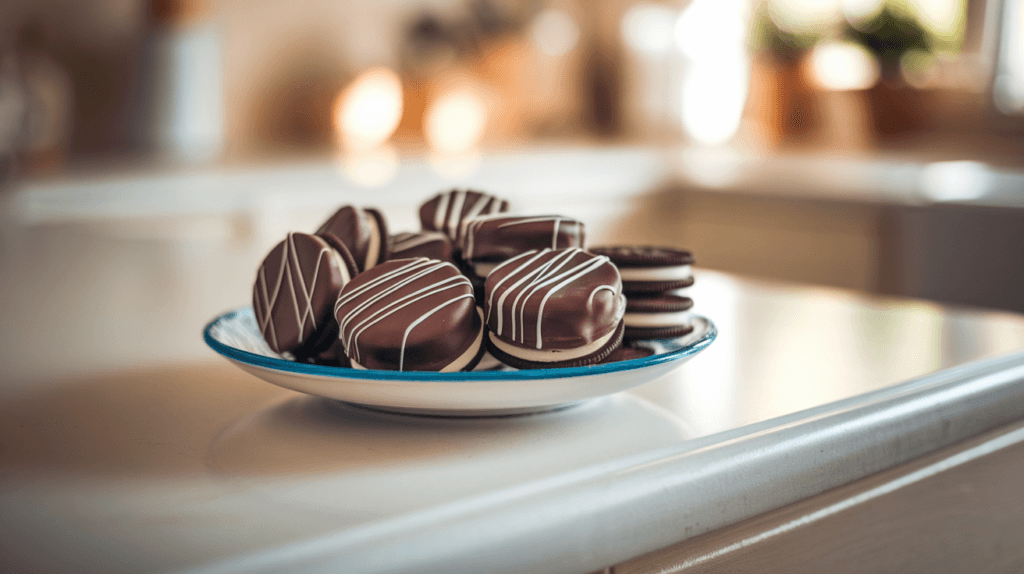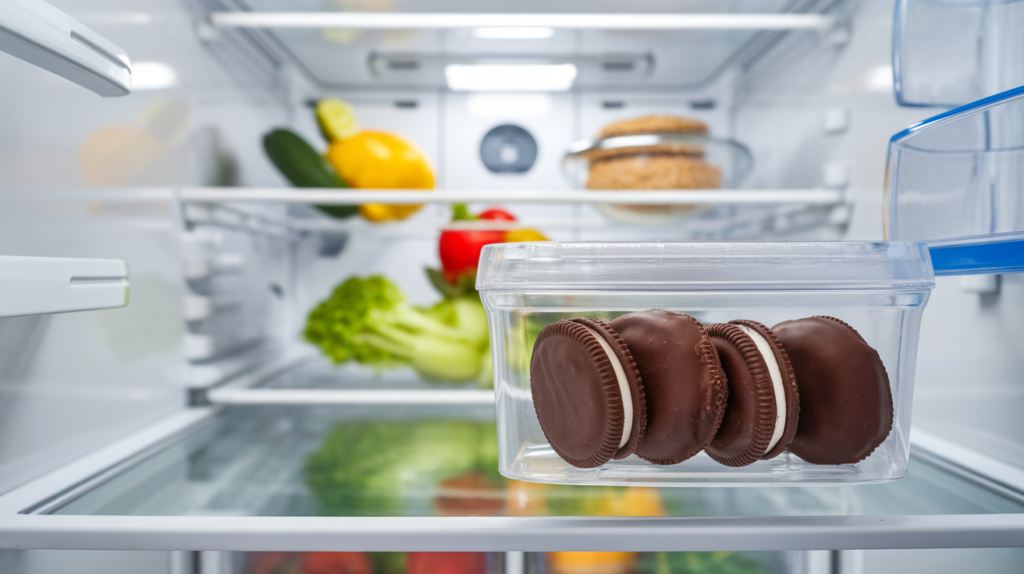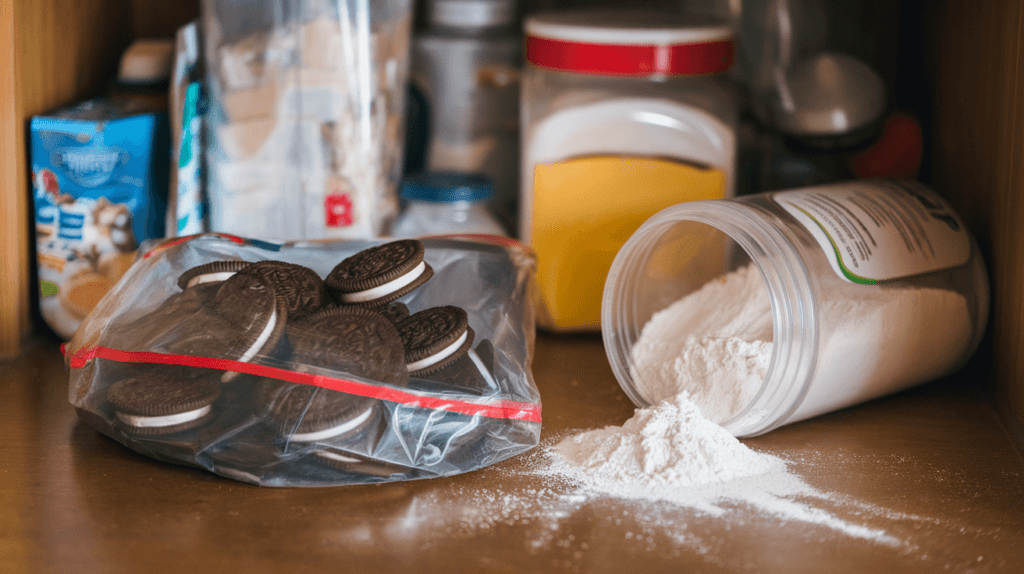Introduction

Chocolate-covered Oreos are a delightful treat, combining the crunch of a classic Oreo with the smooth, creamy taste of chocolate. However, their proper storage is essential to ensure they remain as delicious as the day they were made. One of the most common questions asked is, “Should chocolate-covered Oreos be refrigerated?” The answer depends on various factors, such as the ingredients, environment, and how soon you plan to enjoy them. This article explores the best ways to store chocolate-covered Oreos to keep their texture and taste intact.
In this guide, we’ll discuss why proper storage is essential, the pros and cons of refrigeration, alternatives to refrigeration, and mistakes to avoid when storing these indulgent treats. By the end, you’ll have all the information you need to make the best decision for your chocolate-covered Oreos.
Why Proper Storage Matters
Proper storage of chocolate-covered Oreos is crucial for preserving their quality. These treats are sensitive to environmental factors like temperature, humidity, and air exposure, which can significantly affect their texture, flavor, and appearance. Let’s explore why storage plays a key role in maintaining their freshness.
Preserving Freshness and Flavor
Chocolate-covered Oreos combine a delicate balance of ingredients. The chocolate coating is prone to melting or becoming discolored if exposed to high temperatures, while the Oreo filling can dry out over time. Proper storage ensures that these factors are controlled, keeping the cookies fresh and enjoyable.
When stored incorrectly, chocolate may develop a white, powdery coating known as bloom. This occurs when cocoa butter separates due to temperature changes, affecting the visual appeal and taste of the treat. Keeping chocolate-covered Oreos at a stable temperature prevents this issue.
Avoiding Moisture and Staleness
Humidity is another enemy of chocolate-covered Oreos. Moisture can cause the cookie to become soggy, while the chocolate coating may lose its smooth texture. Additionally, exposure to air can lead to staleness, diminishing the crispness of the Oreo and the richness of the chocolate.
By understanding the impact of improper storage, you can make informed decisions about how to keep your chocolate-covered Oreos at their best. The following sections will delve deeper into whether refrigeration is necessary and alternative storage methods.
Refrigerating Chocolate-Covered Oreos

Refrigeration is a common solution for preserving perishable treats, but is it the best option for chocolate-covered Oreos? While refrigeration can be beneficial in some circumstances, it may not always be necessary. Let’s explore the pros and situations when refrigerating these cookies is recommended.
Benefits of Refrigerating Chocolate-Covered Oreos
Wondering, “Should chocolate-covered Oreos be refrigerated?” In warmer climates, refrigeration helps prevent melting and ensures freshness. The cool temperature maintains the firmness of the chocolate coating, ensuring it retains its smooth texture and glossy appearance. Additionally, refrigeration can extend the shelf life of the cookies by slowing down the oxidation process that can lead to flavor degradation.
If the cookies are homemade and include additional perishable ingredients like cream or fresh fruit, refrigeration is essential to prevent spoilage. Keeping them in the fridge ensures that these ingredients remain safe to consume while preserving the overall taste and quality of the treat.
When to Refrigerate
Refrigeration is most appropriate in the following scenarios:
- Hot or Humid Climates: If you live in an area where room temperatures frequently exceed 75°F (24°C), refrigeration is recommended to prevent the chocolate from melting.
- Extended Storage: If you don’t plan to eat the cookies within a few days, refrigerating them can help maintain their freshness for a longer period.
- Perishable Additions: For chocolate-covered Oreos with added toppings like cream-based drizzles or fresh fruit, refrigeration is necessary to prevent spoilage.
Potential Drawbacks of Refrigeration
While refrigeration can be helpful, it also has potential downsides. Chocolate may absorb odors from other foods in the fridge, which can alter its flavor. To prevent this, it’s essential to store the cookies in an airtight container. Additionally, the cold temperature can cause condensation to form on the chocolate when removed from the fridge, leading to a sticky texture.
Another consideration is the impact on the Oreo’s texture. Prolonged refrigeration may cause the cookie to lose some of its crispness, particularly if not stored in a moisture-proof container.
To strike the right balance, weigh the benefits of refrigeration against its drawbacks and consider the specific needs of your chocolate-covered Oreos.
Alternatives to Refrigeration
If you prefer not to refrigerate your chocolate-covered Oreos, there are alternative methods to keep them fresh and delicious. Proper room-temperature storage can be just as effective when done correctly, particularly in cooler climates or during the fall and winter months.
Room-Temperature Storage
Chocolate-covered Oreos can be safely stored at room temperature, provided the environment meets certain conditions. The ideal storage temperature is between 60°F and 70°F (15°C to 21°C), which helps preserve the integrity of both the chocolate coating and the cookie. Ensure the storage area is dry, as humidity can lead to moisture absorption and soggy cookies.
For best results, place the cookies in an airtight container to protect them from air exposure. This prevents staleness and maintains the crispness of the Oreo. You can also add a small food-safe desiccant packet to the container to absorb any residual moisture and further extend their shelf life.
Best Practices for Room-Temperature Storage
Follow these tips to ensure your chocolate-covered Oreos remain fresh when stored at room temperature:
- Keep Them Away from Heat Sources: Avoid placing the container near heat sources like ovens, stovetops, or direct sunlight, as these can cause the chocolate to melt.
- Choose a Cool, Dark Location: Pantries, cabinets, or closets make excellent storage spaces, as they provide a stable environment away from light and temperature fluctuations.
- Separate Layers: If storing multiple layers of cookies in one container, place a sheet of parchment or wax paper between layers to prevent them from sticking together.
Using Vacuum Sealing for Longer Storage
If you need to store chocolate-covered Oreos for an extended period without refrigeration, vacuum sealing is an effective option. This method removes air from the packaging, significantly reducing the risk of oxidation and staleness. Once vacuum-sealed, store the package in a cool, dry location to maximize the shelf life of your treats.
Keep in mind that even at room temperature, chocolate-covered Oreos are best consumed within 1 to 2 weeks for optimal flavor and texture. Beyond this timeframe, the quality may begin to diminish.
When Room-Temperature Storage Isn’t Suitable
There are situations where room-temperature storage may not be appropriate, such as during heatwaves or in homes without air conditioning. In such cases, refrigeration or freezing may be better options to prevent spoilage. The following section will discuss common mistakes to avoid when storing chocolate-covered Oreos, regardless of the chosen method.
Common Mistakes in Storing Chocolate-Covered Oreos

Proper storage is essential for maintaining the quality of chocolate-covered Oreos, but common mistakes can compromise their flavor, texture, and overall appeal. Avoiding these pitfalls will ensure your treats stay fresh and delicious for as long as possible.
Exposing to Direct Sunlight
One of the biggest mistakes is leaving chocolate-covered Oreos in direct sunlight. Sunlight can quickly raise the temperature, causing the chocolate coating to melt and the cookies to become messy and less enjoyable. Always store them in a cool, dark place to avoid this issue.
Storing in High-Humidity Environments
Humidity can ruin the texture of chocolate-covered Oreos. If you wonder, “Should chocolate-covered Oreos be refrigerated?” consider the climate. Storing them in humid areas, such as near windows or in unsealed containers, can result in a less-than-ideal texture. Using airtight containers and desiccant packets can help protect your cookies from excess moisture.
Using Non-Airtight Containers
Another common mistake is using containers that don’t seal properly. Air exposure can cause the Oreo cookies to become stale and the chocolate coating to lose its rich flavor. To maintain freshness, always use high-quality, airtight containers. This also helps prevent the cookies from absorbing odors from their surroundings, especially if refrigerated.
Refrigerating Without Proper Packaging
If you decide to refrigerate your chocolate-covered Oreos, failing to use proper packaging is a common error. The cold environment of the refrigerator can introduce condensation, leading to a sticky chocolate surface and potential flavor alterations. To avoid this, place the cookies in a sealed, airtight container or wrap them tightly in plastic wrap before refrigerating.
Ignoring the Storage Duration
Even with proper storage, chocolate-covered Oreos have a limited shelf life. Keeping them for too long can lead to diminished flavor and texture. Whether stored at room temperature or in the fridge, it’s best to consume them within 1 to 2 weeks for optimal enjoyment.
Stacking Without Separation
Stacking cookies without using separators like parchment or wax paper can cause them to stick together. This is especially problematic if the chocolate softens slightly, leading to a messy presentation. Always place a layer of parchment or wax paper between stacked cookies to keep them intact.
Freezing Without Preparation
While freezing is a viable option for long-term storage, many people make the mistake of freezing chocolate-covered Oreos without proper preparation. Directly placing them in the freezer can result in freezer burn or texture changes. To freeze correctly, wrap the cookies individually in plastic wrap or place them in a freezer-safe container with layers separated by wax paper.
By avoiding these common mistakes, you can ensure that your chocolate-covered Oreos stay fresh, flavorful, and ready to enjoy. The next section will address frequently asked questions about storing these delicious treats to provide even more clarity on the topic.
FAQ
Here are some of the most frequently asked questions about storing chocolate-covered Oreos, along with detailed answers to help you make the best choices for your treats.
1. Can chocolate-covered Oreos be stored at room temperature?
Yes, chocolate-covered Oreos can be stored at room temperature as long as the environment is cool, dry, and free from direct sunlight. Use an airtight container to maintain freshness and protect the cookies from moisture and air exposure. Room-temperature storage works best in climates where the temperature stays between 60°F and 70°F (15°C to 21°C).
2. How long do chocolate-covered Oreos last?
Should chocolate-covered Oreos be refrigerated for longer freshness? If stored at room temperature, they remain good for up to two weeks. Refrigeration can extend their shelf life to about 3 weeks, while freezing them can preserve their quality for up to 3 months. However, for the best flavor and texture, it’s recommended to consume them sooner rather than later.
3. Will refrigerating chocolate-covered Oreos change their texture?
Refrigerating chocolate-covered Oreos can sometimes affect their texture, especially the Oreo cookie itself, which may lose its crispness over time. Additionally, condensation may form on the chocolate surface when removed from the fridge, making it sticky. Using airtight containers and avoiding prolonged refrigeration can help minimize these issues.
4. Can you freeze chocolate-covered Oreos?
Yes, chocolate-covered Oreos can be frozen for long-term storage. To freeze them properly, wrap each cookie in plastic wrap or place them in a freezer-safe container with parchment or wax paper between layers. When ready to eat, allow the cookies to thaw at room temperature to prevent condensation from forming on the chocolate.
5. How do you prevent chocolate-covered Oreos from melting?
To prevent melting, store chocolate-covered Oreos in a cool, dark place away from heat sources and direct sunlight. If the room temperature exceeds 75°F (24°C), refrigeration is recommended. Always use airtight containers to protect the cookies from air and moisture.
6. What is chocolate bloom, and how can it be avoided?
Chocolate bloom, a common issue with sweets, often raises the question: “Should chocolate-covered Oreos be refrigerated to avoid it?” While it doesn’t affect the safety of the chocolate, it can alter the texture and appearance. To prevent bloom, store chocolate-covered Oreos at a stable temperature and avoid exposing them to moisture.
7. Can chocolate-covered Oreos absorb odors from other foods?
Yes, chocolate can absorb strong odors from other foods if not properly stored. To prevent this, always use an airtight container when storing chocolate-covered Oreos, especially in the refrigerator or freezer.
8. Do homemade chocolate-covered Oreos require refrigeration?
It depends on the ingredients used. If homemade chocolate-covered Oreos include perishable toppings like fresh fruit or cream-based drizzles, they should be refrigerated to prevent spoilage. Otherwise, room-temperature storage is sufficient for simple chocolate coatings.
9. Can you ship chocolate-covered Oreos?
Yes, but special care must be taken to ensure they don’t melt or break during transit. Use insulated packaging, add cooling packs if necessary, and ship them quickly to preserve their quality.
10. Are there specific containers recommended for storing chocolate-covered Oreos?
Yes, airtight containers made from plastic or glass work best for storing chocolate-covered Oreos. For added protection, use food-safe desiccant packets to absorb moisture and keep the cookies fresh longer.
These FAQs should help clarify any concerns you may have about storing chocolate-covered Oreos. With the right storage practices, you can enjoy these delightful treats at their very best.
Conclusion
Deciding whether to refrigerate chocolate-covered Oreos ultimately depends on your storage environment and personal preferences. While refrigeration can extend their shelf life and protect them from heat, it’s not always necessary in cooler, dry conditions. Proper room-temperature storage can keep your treats fresh for up to two weeks when done correctly.
If you choose to refrigerate or freeze your chocolate-covered Oreos, take steps to protect them from condensation, moisture, and odor absorption. Airtight containers and careful handling are key to preserving their flavor and texture. For those in warmer climates or with perishable ingredients in their cookies, refrigeration becomes an essential choice to ensure freshness.
By avoiding common storage mistakes and following best practices, you can enjoy your chocolate-covered Oreos at their finest. Whether you’re indulging in a homemade batch or savoring store-bought ones, proper storage ensures every bite remains as delightful as intended.
Now that you know how to store chocolate-covered Oreos, you can make the most of these irresistible treats, whether you keep them at room temperature, refrigerate, or even freeze them for later enjoyment!

